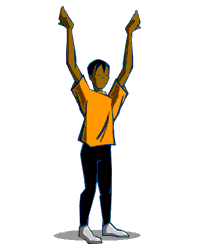|
Scooter Balances
- Outcome A (K-3)-3
Examples of nonlocomotor
skills include turning, twisting, swinging, balancing, bending,
landing, stretching, curling and hanging. The following activity
explores balances.
Give each child a scooter
board. Discuss the safety issues involved with the scooters "scooting"
away if students stand on them. Students should be aware of the
importance of leaving space between one another and the need for
extra space to stop. The importance of placing hands so they do
not become pinched between floor and wheels should be taught.
Discuss large body parts
(back, stomach and rear end) and small body parts (knees, elbows,
hands, and fingers).
Call out tasks for the
children to solve on the scooter:
- Show me how you can balance on your scooter
on three body parts.
- Show me how you can balance on your scooter
at a low level, in a wide shape on one body part.
- Show me a balance on two body parts -
one on the floor and one on your scooter.
Complete the activity by playing a game
of "Red Light Green Light" on scooters. One student is chosen to
be the leader. He/she stands in the center of the gym and all others
are at one end of the gym behind a starting line. On his/her signal,
he/she calls out "green light" or "red light". On "green light"
the children at the end of the gym attempt to move across the gym.
On "red light" all students must immediately stop and
create a balance on their scooter. The student in the middle watches
for students who do not stop immediately and if there are any, sends
them back to the starting line. The object of the game is not to
be the last one across to the other side of the gym. The next leader
can be either the first student across or the last.
"Green light, stop sign" is another variation
of this game that children like to play. When it is time to stop,
the leader calls out the type of "stop" that must be performed (e.g.,
a three-way stop means a balance on three body parts).


If scooters are not available, this activity could
be done on a small individual gymnastic mat or small square of carpet.
For Grades 2 and 3, add the challenge of making
some balances on large or small body parts. (For example, show a
balance on three body parts where one is a large body part.)

These
are clues that you have reached the outcomes ...
Students can demonstrate safe balances and
hold for 3 seconds.
back
to top
|


